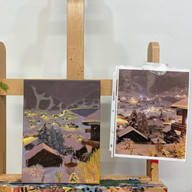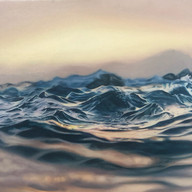At Insight, we believe in supporting kids by giving them a place to learn real techniques that help them draw and paint with confidence. Since opening our doors in 2016, we have created a nurturing environment where young artists learn at their own pace and follow their own interests, within a structured, skill-based program. We teach kids the fundamentals of drawing and painting, in art classes tailored to each student's age, interests and abilities.

Small Group Art Classes For Kids
Our kids classes are small groups of students (max 8 to 1 ratio) of various ages, from 8 to 16. We offer each student step-by-step instruction and feedback as students work through a project of their choice.
Our classes are guided work-sessions. Kids are welcomed into our classes and will find their current project set out and ready to go, and their work station stocked with all of the supplies they'll need for class. Our instructors check in with each student individually, working around the classroom with students to guide kids through their projects one step at a time. We break each project into manageable steps and demonstrate important concepts and techniques along the way. As kids gain new skills, they create paintings that fill them with pride and confidence. Kids in our program learn by doing.
Each session, we introduce new concepts and materials to kids in our classes. With input from our instructors, students choose projects that fit their interests and abilities. Students work on what they are inspired to create, and we guide them through each project giving age and skill-appropriate instruction.
Please note, students are not required to move to a new material each session, and can remain working in a particular medium for as long as they wish.
Session One: Drawing
Students in their first session with us learn the fundamentals of drawing. We begin with projects in pastel and charcoal, and we use these projects to teach kids fundamental drawing skills like:
Observational drawing. Kids learn to draw what they see by noticing the subject rather than drawing symbolically.
Drawing Construction. Kids learn to set themselves up for success by building their drawings up in a logical way, and learning to work from big, general shapes to more specific detailed shapes.
Shading and Rendering. Kids learn to use both color and value to create the illusion of three-dimensional form.
Measurement Techniques: Kids learn age appropriate techniques to check the relationships between different sized objects in their drawings.
Session 2: Watercolor
In their second session with us, students learn how to use watercolor paints. Here, we utilize all of the skills that we learned in drawing, while adding a new layer of complexity as students learn how to use a new material. Watercolor paint can often be combined with watercolor pencil, and line work can be added with ink, gel pen or Posca markers for a mixed media effect. In watercolor, kids learn:
Color Theory. Kids complete a color wheel learning primary, secondary and complementary colors.
Watercolor Painting Techniques. Flat wash, wet-into-wet wash, dry brushing, masking, and more!
Painting Construction. Kids learn how to use transparent washes to build a painting from block-in to finishing details.
Session Three and Beyond: Acrylic Painting
Students in their third session with us begin acrylic painting on canvas. There are a wide range of projects that students might work on in acrylic; from small and simple paintings to larger and more complex pieces. Their choices are guided by their instructors. Students in acrylic are introduced to a "full palette" and are given two of each primary color, in addition to earth tones, white, and black. Acrylic offers so many new challenges and possibilities that students typically stay in acrylic for multiple sessions. Students in acrylic painting learn:
Color Theory. We continue to learn about color by introducing a "warm and a cool" for each primary color.
Acrylic painting techniques. Students learn to use acrylic from thin wash, to smooth blend, and from layered brush strokes to palette knife application. With acrylic, the sky is the limit!
Painting construction. Kids learn how to construct a painting from rough block-in to finishing details.
Advanced Students: Oil Painting
Advanced students are introduced to oil painting. Students must have a high degree of mastery working with acrylic, must be able to easily mix paint to match a color, and have instructor approval. Our advanced students in oil learn:
Color Theory. Just like in watercolor and acrylic, students in oil complete a color wheel, learning to mix with a full palette of oil paint, including: a warm and cool version of each primary, earth tones, white and black.
How to apply oil paint in layers. Creating an oil painting in layers takes careful planning and knowledge of the materials. We show students how to build a painting from a thin block-in to a thicker finishing layer.
Oil painting techniques. Oil paint can be smooth and blended, thick and textured or anything in between. Students will learn new techniques to create the work they envision.
Independent Study / Portfolio Prep
Students who have completed instruction in all of our offered drawing and painting materials embark on independent study where they focus on a particular theme, explore a specific material or create a "series" of artworks meant to be shown together. Our instructors can assist students with all aspects of developing a body of work for personal expression, or with portfolio development towards a high school, college or other application.






































































































Comments